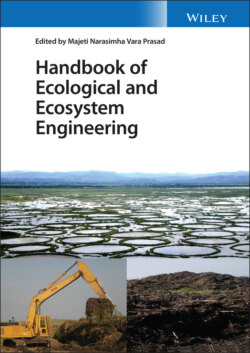Читать книгу Handbook of Ecological and Ecosystem Engineering - Группа авторов - Страница 10
Preface
ОглавлениеThere is a growing global concern about environment and sustainable development. The 2030 Agenda for Sustainable Development was launched in 2015 to end poverty and set the world on a path of peace, prosperity and opportunity for all on a healthy planet (UN Sustainable development goals 2015). The 17 Sustainable Development Goals (SDGs) demand nothing short of a transformation of the financial, economic and political systems that govern our societies today to guarantee the human rights of all. They require immense political will and ambitious action by all stakeholders. Global efforts to date have been insufficient to deliver the desired to current and future generations. Due to COVID‐19, globally visible and an unprecedented health emergency, economic and social crisis, threatening lives and livelihoods jeopardizing the SDG’s Agenda’s promise to the current and future generations.
In this regard an integrated approach of management and restoration of ecosystems is a clear global concern. With increasing population explosion and exploitation of natural capital pressure on the planet earth is steeply increasing. In the last half century, the world human population has doubled, the consumption of natural resources has been multiplied by six, biodiversity has drastically decreased and the degradation of many ecosystems and global environmental modifications are glaring.
Odum H.T., used the term “ecological engineering” in 1960s, in several publications. Mitsch and Jørgensen highlighted the necessity of ecological engineering in 1989.
Ecology and Ecosystems study is the only scientific field capable of providing the scientific bases necessary to implement ecosystem manipulations e.g. to mitigate the effect of global climatic changes. Such ecosystem manipulations could potentially have very negative impacts if not well designed.
Conversely, modern scientific ecology needs concrete examples of applied management Practitioners, stakeholders, and policy makers for ecosystem engineering are indeed good forcing processes to encompass the range of the studied ecological variables in terms of heterogeneity, limits and the occurring interactions between these variables.
In the same vein, the full development of ecological engineering requires stakeholders, scientists from engineering sciences, socio‐economical sciences, and all environmental sciences to work together both to build a common general framework and to ground their work on concrete common projects.
Ecological engineering is also particularly relevant for developing countries. Indeed, the need for sustainable exploitation of ecosystems is very high in these countries where populations are still quickly growing and where individuals and institutions have often difficulties to develop practices based on high input rates (energy, water, mineral nutrients).
In this context this book assumes considerable significance. Thus, this book aimed at integrating multiple ecosystem services of the “Earth Ecosystem” resources (biotic and abiotic) keeping in view the UN 17 Sustainable Development Goals. Phytobiome and microbiome services that humans derive are focussed. Essentially Ecological and Ecosystem Engineering principles of the global ecosystem (Earth) for sustainable development will be dealt in this work
Goals of Ecological Engineering are
1 the restoration of ecosystems that have been substantially disturbed by human activities such as environmental pollution or land disturbance
2 the development of new sustainable ecosystems that have both human and ecosystems, and ecological value.
3 Ecological restoration ‐ the return of an ecosystem to a close approximation of its condition prior to disturbance
Terms that are synonyms, subdisciplines, or fields similar to the crux of this books are: Bioengineering, biomanipulation, biospherics, ecohydrology, ecological engineering ecosystem rehabilitation, ecotechnology, engineering ecology, habitat reconstruction, nature cure, nature engineering, reclamation ecology, restoration ecology, river and lake restoration, solar aquatics, sustainable development, agroecology, synthetic ecology and wetland restoration.
Ecological Engineering ‐ the design of sustainable ecosystems that integrate human ecosystems with its natural environment for the benefit of both. An attempt has been made and designed for the benefit of Environmental Engineers, Pollution Engineers and Energy Engineers, Researchers working in Water, Energy footprints, Carbon foot print, Environmental Biotechnologists etc. Researchers and academicians, undergraduate and graduate students in the broad area of Environmental Sciences, Ago‐forestry and agronomy, Land scape engineers etc.
65 Authors from 9 countries viz., Brazil, Germany, India, Ireland, Poland, Portugal, Romania, Russia and Sri Lanka participated and contributed to various topics listed below:
1 Ecological engineering and ecosystem services ‐ theory and practice
2 Ecological and ecosystem engineering for economic and environmental revitalization
3 Environmental issues and priority areas for ecological engineering initiatives
4 The role of Soil meso and macrofauna indicators for restoration assessment success in rehabilitated mine site
5 Urban Environmental issues – solutions by ecological and ecosystem engineering
6 Mitigation of Urban Environmental issues by applying ecological and ecosystem engineering
7 Soil fertility restoration, theory and practice
8 Extracellular soil enzymes act as moderator to restore carbon in the soil habitats
9 Ecological engineering for solid waste reduction and resource recovery
10 Urban floods and mitigation by applying ecological and ecosystem engineering
11 Ecological engineering and restoration of mine ecosystems
12 Restoration of abandoned mines
13 Wetland and watershed Lake restoration
14 Restoration of Riverine Health: An Ecohydrological Approach ‐ Flow Regimes and Aquatic Biodiversity
15 Ecosystem services of phoomdi islands of Loktak, a dying Ramsar site in north‐east India
16 The application of reefs in shoreline protection
17 Mangroves, as shore engineers, are nature‐based solutions for ensuring coastal protection
18 Forests degradation prevention through nature‐based solution: an Indian perspective
19 Restoring Ecosystem Services of Degraded Forest Ecosystems in a Changing Climate
20 Forest degradation prevention
21 Use of plants for air quality improvement
22 Phylloremediation for Mitigating Air Pollution
23 Air quality improvement using green cover
24 Air quality improvement using phytodiversity and plant architecture
25 Information explosion in digital science and ecosystems
26 Nanotechnology in Ecological and Ecosystem Engineering
Editor
22‐10‐2020
